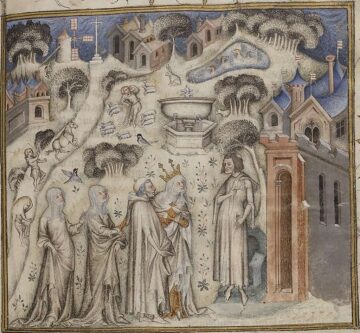Alex Ross at The New Yorker:
 Guillaume de Machaut, the master poet-composer of fourteenth-century France, served for many years as the canon of the great Gothic cathedral at Reims, where the kings of the realm were crowned. Machaut’s most famous creation, the Messe de Nostre Dame, has a singular place in musical history, because it is an early attempt at creating a comparably sublime edifice in sound—a six-movement work in four-part polyphony, lasting well over half an hour, in which austere, granitic harmony is set against delicate contrapuntal play and spiky rhythmic motion. This Mass is, in fact, the oldest extant piece of its type to have been attributed to a single composer. When, the other day, the San Francisco-based vocal ensemble Chanticleer sang it at Grace Cathedral, on Nob Hill, a suitable atmosphere of awe accumulated.
Guillaume de Machaut, the master poet-composer of fourteenth-century France, served for many years as the canon of the great Gothic cathedral at Reims, where the kings of the realm were crowned. Machaut’s most famous creation, the Messe de Nostre Dame, has a singular place in musical history, because it is an early attempt at creating a comparably sublime edifice in sound—a six-movement work in four-part polyphony, lasting well over half an hour, in which austere, granitic harmony is set against delicate contrapuntal play and spiky rhythmic motion. This Mass is, in fact, the oldest extant piece of its type to have been attributed to a single composer. When, the other day, the San Francisco-based vocal ensemble Chanticleer sang it at Grace Cathedral, on Nob Hill, a suitable atmosphere of awe accumulated.
Yet the Mass is ultimately not Machaut’s most striking achievement. Superbly constructed as the score is, it does not mark a leap beyond other, anonymous masses of the period. Chanticleer augmented the movements of the Mass with a generous selection of Machaut’s works in secular forms, for which he wrote both texts and music: ballades, rondeaux, lais, virelays, and motets.
more here.
